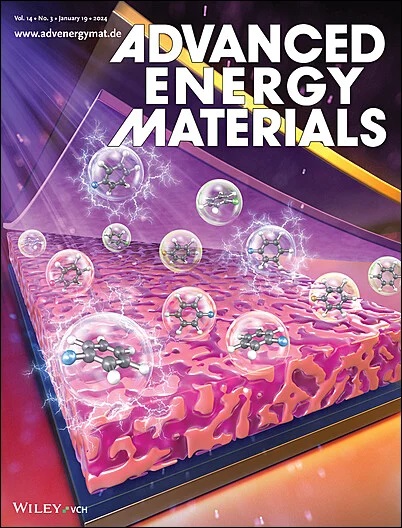Tuning Anion Chemistry to Enhance Bulk and Interfacial Stability in Low‐Temperature Lithium Metal Batteries
IF 24.4
1区 材料科学
Q1 CHEMISTRY, PHYSICAL
引用次数: 0
Abstract
The stable operation of lithium metal batteries in cold climates is significantly constrained by insufficient dynamics within both the bulk and interfacial regions of the electrolyte. In the study, an in‐situ polymerized quasi‐solid‐state electrolyte employing a ternary‐anion system with co‐initiators to enhance its anti‐freezing performance is proposed. A competitive strategy, driven by the co‐initiators, modifies the Li调整阴离子化学以增强低温锂金属电池的体积和界面稳定性
锂金属电池在寒冷气候下的稳定运行受到电解液体积和界面区域内动力学不足的显著限制。在这项研究中,提出了一种原位聚合准固态电解质,采用三元阴离子体系和共引发剂来增强其抗冻性能。由共引发剂驱动的竞争策略改变了Li+配位环境,削弱了溶剂化结构,调节了大块电解质中的分子链,有效地降低了锂的运输屏障。同时,聚合物电解质有助于在锂金属电极上形成由富liff层和富银层组成的双层间相。在- 20°C时,体相和界面相的协同作用导致Li+迁移数高达0.78。因此,电解质有效地抑制了锂枝晶的生长,使锂对称电池在- 20°C和10 mA cm - 2的电流密度下稳定运行超过600小时。此外,Li||LFP电池在- 20°C和20 mA g - 1条件下循环150次后仍保持93.65%的容量。这项工作为合理设计具有优化体积和界面性能的多阴离子电解质提供了新的见解,用于先进的低温锂金属电池。
本文章由计算机程序翻译,如有差异,请以英文原文为准。
求助全文
约1分钟内获得全文
求助全文
来源期刊

Advanced Energy Materials
CHEMISTRY, PHYSICAL-ENERGY & FUELS
CiteScore
41.90
自引率
4.00%
发文量
889
审稿时长
1.4 months
期刊介绍:
Established in 2011, Advanced Energy Materials is an international, interdisciplinary, English-language journal that focuses on materials used in energy harvesting, conversion, and storage. It is regarded as a top-quality journal alongside Advanced Materials, Advanced Functional Materials, and Small.
With a 2022 Impact Factor of 27.8, Advanced Energy Materials is considered a prime source for the best energy-related research. The journal covers a wide range of topics in energy-related research, including organic and inorganic photovoltaics, batteries and supercapacitors, fuel cells, hydrogen generation and storage, thermoelectrics, water splitting and photocatalysis, solar fuels and thermosolar power, magnetocalorics, and piezoelectronics.
The readership of Advanced Energy Materials includes materials scientists, chemists, physicists, and engineers in both academia and industry. The journal is indexed in various databases and collections, such as Advanced Technologies & Aerospace Database, FIZ Karlsruhe, INSPEC (IET), Science Citation Index Expanded, Technology Collection, and Web of Science, among others.
 求助内容:
求助内容: 应助结果提醒方式:
应助结果提醒方式:


